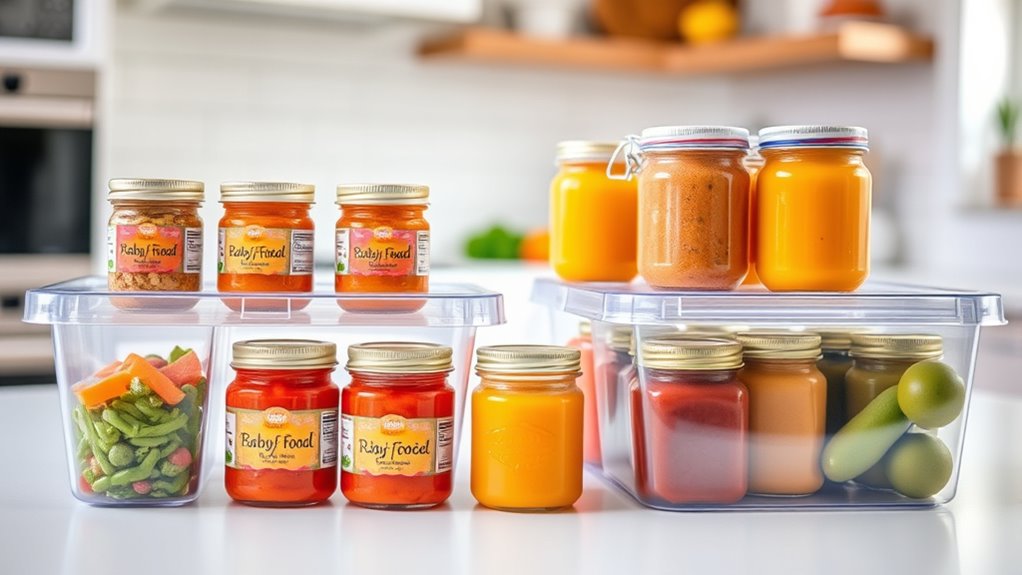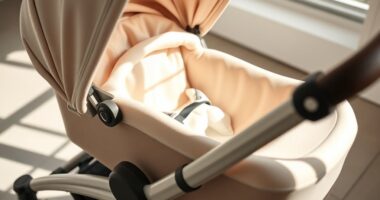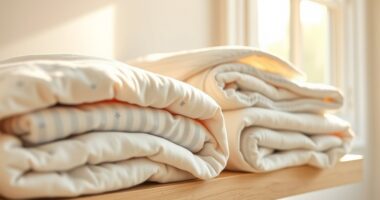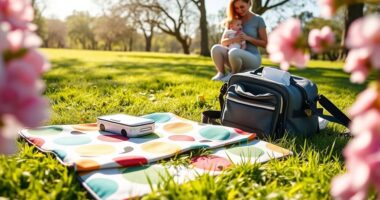Proper baby food storage is more important than you might realize because it keeps your little one safe from bacteria, contamination, and spoilage. Good storage also preserves the nutrients, flavor, and quality of homemade purees, ensuring your baby gets healthy, fresh food every time. Using the right containers and timing your fridge and freezer use helps extend shelf life and reduces waste. To learn key tips that can make your baby’s food safer and more nutritious, keep going.
Key Takeaways
- Proper storage prevents bacterial growth and contamination, ensuring baby’s food remains safe to eat.
- It preserves nutrients, flavor, and freshness, supporting optimal infant nutrition and development.
- Using suitable containers and portioning reduces waste and minimizes the risk of spoilage.
- Correct reheating and handling safeguard against foodborne illnesses and burns.
- Maintaining organized, clean storage areas helps detect spoilage early and maintains overall food quality.

Are you wondering how to keep your baby’s food fresh and safe? Proper storage is more vital than you might think, especially when it comes to preserving nutrients and preventing contamination. When preparing homemade baby food, you want to guarantee each bite is as nutritious and safe as possible. That’s why understanding the essentials of baby food storage can make a huge difference in your little one’s health.
Proper storage of homemade baby food ensures safety, preserves nutrients, and keeps your little one healthy.
One key aspect of maintaining fresh baby food is mastering breastfeeding tips that support your child’s overall nutrition. While breastfeeding provides natural immunity and nutrients, introducing solid foods means you must carefully store homemade purees or leftovers. Proper storage methods help retain the organic ingredient sourcing you’ve carefully selected, ensuring that your baby benefits from the freshest, highest-quality ingredients. When you source organic ingredients, you’re already prioritizing safety and health, so it’s equally vital to maintain those standards through proper storage.
Start by choosing the right containers. Use BPA-free, airtight storage options that prevent air exposure, which can cause spoilage or freezer burn. Small portions are better because they allow you to thaw only what’s needed, reducing waste and limiting potential bacterial growth. Label each container with the date it was made so you can track freshness and avoid using older food. Once prepared, refrigerate the food promptly, ideally within two hours, to inhibit bacterial growth. If you don’t plan to use the food within 48 hours, freezing is your best option. Freezing preserves nutrients and flavor while extending shelf life, but make sure to leave some space in the container for expansion as the food freezes. Additionally, understanding proper storage techniques can significantly impact the safety and quality of homemade baby food.
When reheating, always guarantee that the food is heated evenly to avoid hot spots that could burn your baby’s mouth. Stir thoroughly and check the temperature before feeding. Avoid refreezing leftovers multiple times, as this can compromise safety and quality. Keep the storage area clean and organized to prevent cross-contamination, and regularly check for signs of spoilage like sour smells, discoloration, or mold.
Frequently Asked Questions
How Long Can Homemade Baby Food Be Safely Stored?
You can generally store homemade baby food for up to 48 hours in the refrigerator, following safety guidelines to prevent spoilage. If you want to keep it longer, freezing is your best option, typically up to 3 months. Always label containers with dates, and check for any signs of spoilage before serving. Proper storage duration and safety guidelines help make sure your baby’s food remains fresh and safe to eat.
What Are the Best Materials for Baby Food Storage Containers?
When choosing baby food storage containers, you should focus on plastic safety and material durability. Opt for BPA-free plastics that won’t leach harmful chemicals into your baby’s food. Look for sturdy, shatter-resistant materials that can handle freezing and reheating without cracking. These containers guarantee your baby’s food stays safe and fresh, giving you peace of mind. Always check for food-grade labels to ensure you’re selecting the best, safest options.
Can Freezing Baby Food Affect Its Nutritional Value?
You might find it surprising, but freezing baby food generally preserves nutrients well if done correctly. While freezer burn can affect texture, it doesn’t notably harm nutrient preservation. Proper storage, like using airtight containers, minimizes nutrient loss. Freezing is a safe, convenient way to keep baby food fresh, ensuring your little one gets essential nutrients without compromising quality. Just remember to label and rotate stored food regularly!
How Should I Thaw Frozen Baby Food Safely?
To thaw frozen baby food safely, you should use proper thawing techniques that prioritize temperature control. The best method is to transfer the food to the refrigerator and let it thaw slowly, ensuring it stays between 40°F (4°C) and 32°F (0°C). Avoid leaving it out at room temperature, as this can promote bacterial growth. You can also use the microwave on a defrost setting, but always check the temperature before serving.
Are There Specific Storage Tips for Introducing New Foods?
Did you know that introducing new flavors early can reduce allergy risks? When you store baby food, keep it simple and organized to guarantee fresh options for each new flavor. Label containers with dates and avoid mixing multiple foods to prevent cross-contamination. Proper storage helps you introduce flavors gradually, supporting allergy prevention and ensuring your little one enjoys safe, healthy foods as they explore new tastes.
Conclusion
You might think storing baby food is just about keeping it fresh, but it’s actually about protecting your little one’s health. Some say that improper storage can lead to harmful bacteria or nutrient loss, which could affect development. So, next time you’re putting away those jars or purees, remember: good storage isn’t just a routine—it’s a essential step in giving your baby the best start in life. Trust me, it’s worth the extra effort.









